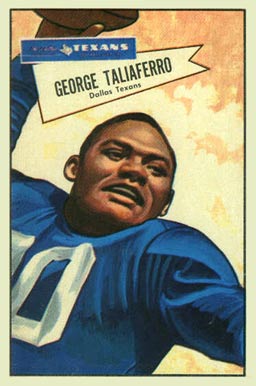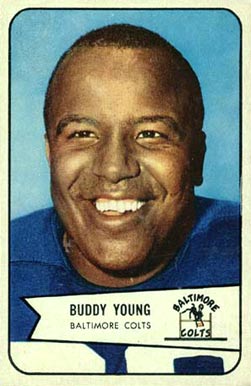
Stephen Wood Van Buren was a Honduran-American professional football halfback who played for the Philadelphia Eagles of the National Football League (NFL) from 1944 to 1951. Regarded as a powerful and punishing runner with excellent speed, through eight NFL seasons he won four NFL rushing titles, including three straight from 1947 to 1949. At a time when teams played 12 games a year, he was the first NFL player to rush for over ten touchdowns in a season—a feat he accomplished three times—and the first to have multiple 1,000-yard rushing seasons. When he retired, he held the NFL career records for rushing attempts, rushing yards, and rushing touchdowns.

Thomas Allen Brown, known also as Timothy Brown, Tim Brown, and Timmy Brown, was an American actor, singer, and football player. He played in the National Football League (NFL) as a running back and return specialist.

Glenn Woodward Davis was an American professional football halfback who played for the Los Angeles Rams of the National Football League (NFL). He is best known for his college football career for the Army Cadets from 1943 to 1946, where he was known as "Mr. Outside". He was named a consensus All-American once, named unanimous All-American twice, and in 1946 won the Heisman Trophy and was named Sporting News Player of the Year and Associated Press Athlete of the Year.
The 1950 NFL season was the 31st regular season of the National Football League. The merger with the All-America Football Conference (AAFC) expanded the league to 13 teams. Meanwhile, television brought a new era to the game. The Los Angeles Rams became the first NFL team to have all of its games – both home and away – televised. The Washington Redskins became the second team to put their games on TV. Other teams arranged to have selected games televised.

Jerry Ralph Williams was an American football player and coach who served as the head coach of two Canadian Football League (CFL) teams, as well as the Philadelphia Eagles of the National Football League (NFL).

George Taliaferro was an American professional football player who was the first African American drafted by a National Football League (NFL) team. Beginning his football career at Indiana University for the Hoosiers team, he played in the NFL for the New York Yanks from 1950 to 1951, the Dallas Texans in 1952, the Baltimore Colts from 1953 to 1954, and Philadelphia Eagles in 1955.

Claude Henry K. "Buddy" Young was an American professional football player and executive in the National Football League (NFL). A native of Chicago, he was Illinois state champ in track and field in the 100-yard dash. The 5'4" Young, also known as the "Bronze Bullet", had exceptional quickness and acceleration. He is one of the shortest men ever to play in the NFL, he was drafted in the 1947 AAFC Draft in the Special Draft by the New York Yankees. As a track star at the University of Illinois, he won the National Collegiate Championships in the 100 and 220-yard dash, tied the world record for the 45 and 60-yard dashes, and was the Amateur Athletic Union's 100-meter champion.

The 1950 NFL Championship Game was the 18th National Football League (NFL) title game, played on Sunday, December 24 at Cleveland Stadium in Cleveland, Ohio.

Robert James "Hunchy" Hoernschemeyer was an American football player. A native of Cincinnati, he played college football as a halfback for the Indiana Hoosiers football in 1943 and 1944 and as a quarterback for the Navy Midshipmen football team in 1945. He led the NCAA in both total offense and passing yards during the 1943 season.
The 1950 Cleveland Browns season was the team's first in the National Football League (NFL) after playing the previous four years in the All-America Football Conference (AAFC), which folded after the 1949 season. The Browns finished the regular season with a 10–2 win–loss record and beat the Los Angeles Rams to win the NFL championship. It was Cleveland's fifth consecutive championship victory, the previous four having come in the AAFC.

Lester Junior "Dick" Hoerner was an American football player. He played fullback for the University of Iowa in 1942 and 1946 and for the Los Angeles Rams from 1947 to 1951. He helped lead the Rams to three consecutive National Football League (NFL) championship games from 1949 to 1951, played for the 1951 Los Angeles Rams team that won the 1951 NFL Championship Game, and was selected to play in the inaugural 1951 Pro Bowl. He was the Rams' all-time leading rusher at the end of his playing career with the team. He concluded his professional football career as a member of the Dallas Texans in 1952.

Daniel Padgett Sandifer was an American professional football player who was a defensive back, halfback, receiver, & kick returner for six teams in the National Football League (NFL) from 1948 to 1953. He played college football for the LSU Tigers. Because of World War II, he was one of the few college players to play in two College All-Star Games. He currently holds the Washington Redskins team record for most interceptions in a season (13) set in his rookie year, 1948. 13 interceptions in a season has been surpassed only once in NFL history by Dick "Night Train" Lane with 14 in 1952 playing for the Los Angeles Rams. Dan recorded 4 interceptions and 2 pick 6s in a single NFL game in 1948. Sandifer also had interceptions in six consecutive games during his rookie year in 1948.

Dominic Angelo Moselle was an American football defensive back and halfback who played in the National Football League (NFL) during the early 1950s.

David Smukler, also known as "Dynamite Dave", was an American football player who played in 38 National Football League games, mostly for the Philadelphia Eagles in the late 1930s. He was also the star player for the Temple University Owls in the inaugural Sugar Bowl game on January 1, 1935, in New Orleans, Louisiana.

Don Cooper "Dopey" Phelps was an American football halfback and defensive back who played for the Cleveland Browns in the National Football League (NFL) in the early 1950s.
Willie Brown was an American college and professional football player and coach. A star college football player for the USC Tojans, he went on to play three seasons in the National Football League (NFL). After his playing career, he served as a coach for the Trojans and the Tampa Bay Buccaneers of the NFL.
Paul Edward Campbell was a college athlete who was the starting quarterback for the Texas Longhorns football team in 1948 and 1949. He was the 22nd pick overall in the 1948 NFL draft, selected by the Philadelphia Eagles.
The 1945 Indiana Hoosiers football team was an American football team that represented the Indiana University Bloomington in the 1945 Big Ten Conference football season, compiled the only undefeated record and won the first Big Ten Conference championship in the program's history. In their 12th year under head coach Bo McMillin, the Hoosiers compiled a 9–0–1 record, outscored their opponents by a combined total of 279 to 56, and finished the season ranked #4 in the final AP Poll. The lone blemish on the team's record was a 7–7 tie with Northwestern in the second game of the season.

Tony Randall Pollard is an American professional football running back for the Tennessee Titans of the National Football League (NFL). He played college football at Memphis, and was drafted by the Dallas Cowboys in the fourth round of the 2019 NFL draft.














